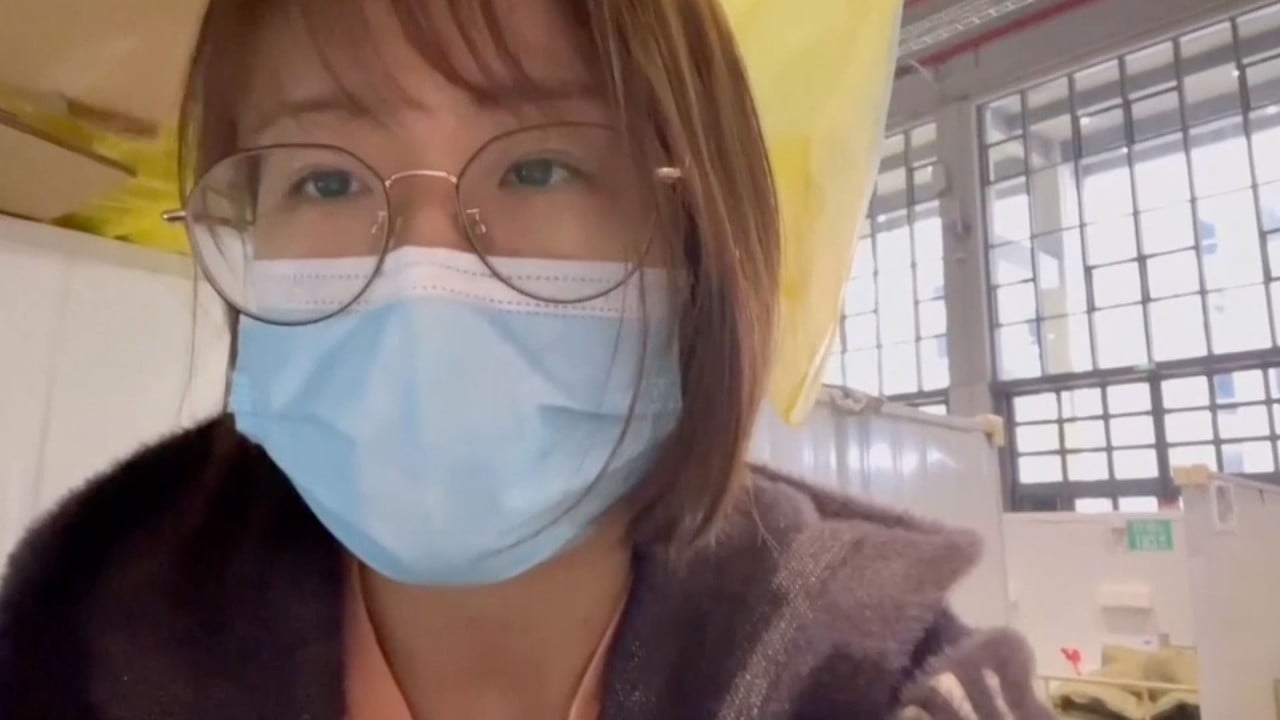
02:10
Inside a Shanghai Covid-19 makeshift hospital where ‘lights are on all night’

A study of Covid-19 patients at a Shanghai children’s hospital found that vaccinated children were twice as likely as unvaccinated minors to show no symptoms. Young patients with Covid-19 also experienced fever for shorter periods than with flu.
The study, at Fudan University’s children’s hospital, also suggests the city’s youngsters may have played an unwitting role in the widespread community transmission behind its worst outbreak since the start of the pandemic.
The results, which covered 376 paediatric Covid-19 patients at the hospital in March, were published on the medRxiv website ahead of peer review.
The children, aged from 11 days to 17 years with a median age of five, were admitted before Shanghai’s policy change allowing non-serious cases to stay in the city’s isolation facilities.
The researchers said the potential transmission role of asymptomatic and mild cases in children had been underestimated in the early stages of Shanghai’s Omicron outbreak, before mass screenings began on March 28.
“After citywide, large-scale screening, notifiable asymptomatic cases accounted for 90 per cent, more or less, in April,” they wrote.
Shanghai’s Omicron outbreak has seen the largest numbers of infected children in the country – with 12,707 cases aged six or below, as of April 28. There is evidence that patients continue to shed the Omicron virus for six to nine days after onset or diagnosis, even after symptoms pass.
The study found that Omicron’s impact on children seemed very mild, with about 31 per cent of the hospital’s Covid-19 patients in March showing no symptoms and no severe cases, according to the hospital’s researchers.
For the 257 who did experience symptoms, the infection’s course was brief. Of the 216 children who had fever, it lasted between 1.7 plus-or-minus 1.08 days, significantly shorter than the four days’ duration common with influenza, they observed.
“For child Covid-19 patients, the duration of fever is shorter and the impact of Omicron looks milder than flu,” said Zeng Mei, professor with the hospital’s department of infectious diseases and lead author of the study.
A total of 104 of the patients experienced a cough, while 16.4 per cent suffered a drop in white blood cell count, known as transient leukopenia.
The study did not include cases from April, when Shanghai’s infections erupted to more than half a million. However, Zeng said the pattern of community transmission in April looked very similar.
“The febrile duration is helpful to differentiate Covid-19 from influenza in children when the epidemics of Covid-19 and influenza overlap,” the authors wrote.
Other symptoms included nausea, vomiting or diarrhoea among 4.2 per cent of the patients, while 0.8 per cent reported a transient loss of taste and smell.
Chest CAT scans were performed on 25 patients, a procedure triggered after three days of a temperature above 38.5 degrees Celsius (101.3 Fahrenheit) or persistent coughing. The researchers said the images showed patchy infiltrates or ground-glass opacity in four cases.
One child was prescribed antibiotics after a clear diagnosis of right lung lobar pneumonia caused by mycoplasma pneumonias.
Ibuprofen and Chinese traditional medicines, sometimes in combination, were prescribed to other symptomatic patients, depending on the severity of their symptoms.
The children were discharged after a negative nucleic test, with an average stay in hospital of between eight and 15.4 days.
The researchers called for a booster vaccine dose to give children more protection from Covid-19, with their study showing that vaccination does help to a degree in preventing symptomatic infection.
The study could not estimate vaccine protection against severe infection, as no severe cases were diagnosed.
By the end of March, more than 70 per cent of Shanghai’s children aged three to 17 years were vaccinated against Covid-19.
Of the 307 children in the study eligible for vaccination, 40.4 per cent had received two doses of inactivated vaccines with a median interval of 3.5 months between two-dose vaccination and infection.
The researchers found that two doses of inactivated vaccine within 17 days to seven months potentially reduced the risk of symptomatic Omicron infection in children by 31 per cent and febrile disease by 59 per cent.
However, a single dose did not significantly decrease the relative risks of symptomatic infection and febrile disease, they said.
They also observed that symptoms were seen significantly more frequently in patients aged three and younger, compared to older children. Half of the double-vaccinated cases were asymptomatic, while only 22.8 per cent – 57 out of 250 – unvaccinated patients had no symptoms.
A third booster shot has yet to be approved children aged three to 17 and the researchers called for approval for this age group “in light of the field findings”.
Current evidence has consistently shown a reduction in neutralising antibodies against Omicron in the blood serum of convalescent or vaccinated individuals, giving the variant a potential escape against vaccine and infection-induced immunity.
Some studies have shown that a third dose can restore vaccine effectiveness, with antibodies increasing quickly from 40 per cent to 80 per cent.
The researchers said the potential role in transmission for most asymptomatic and mild child cases should not be neglected.
“High prevalence of asymptomatic infection is likely to be a major factor in the wide spread of the Omicron variant among the population,” they wrote.